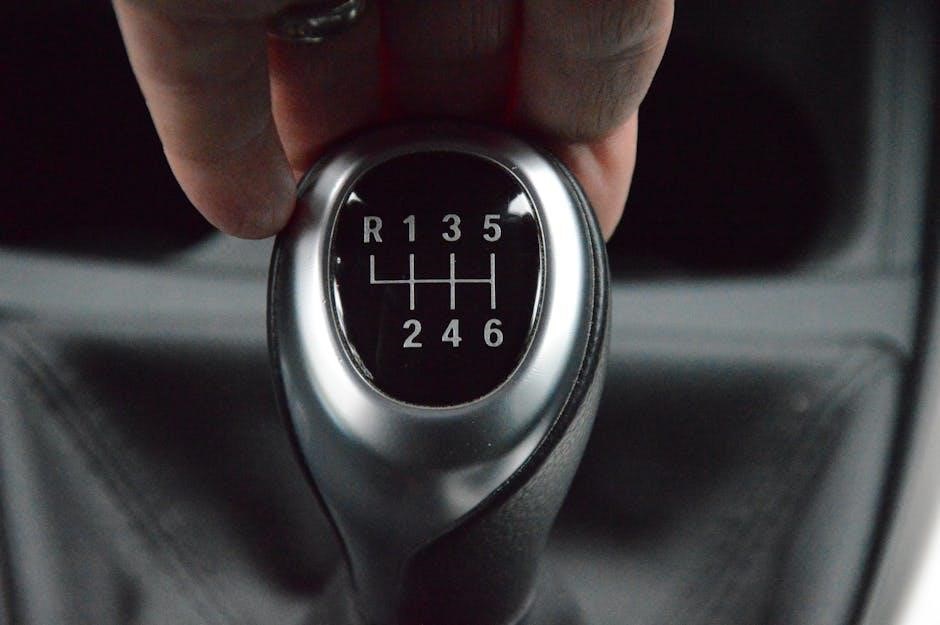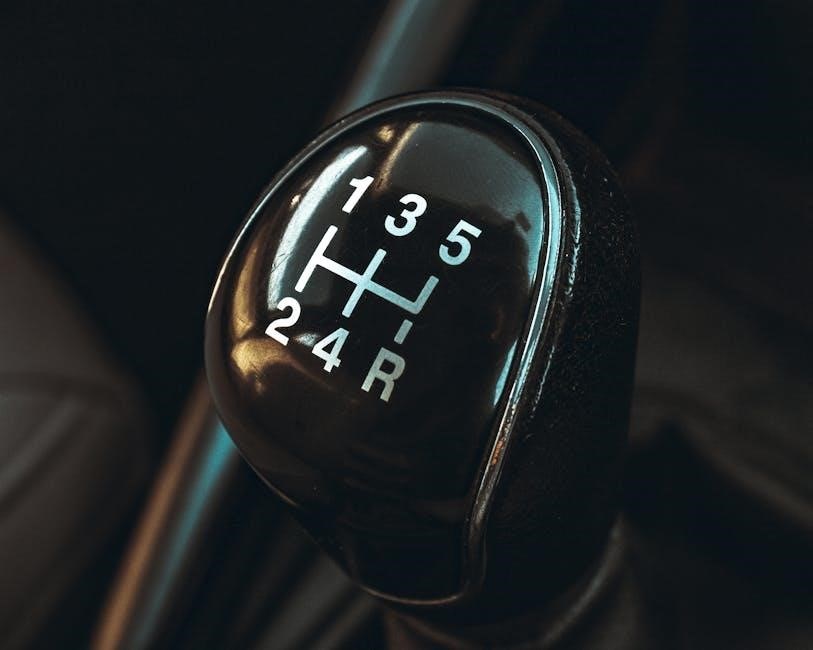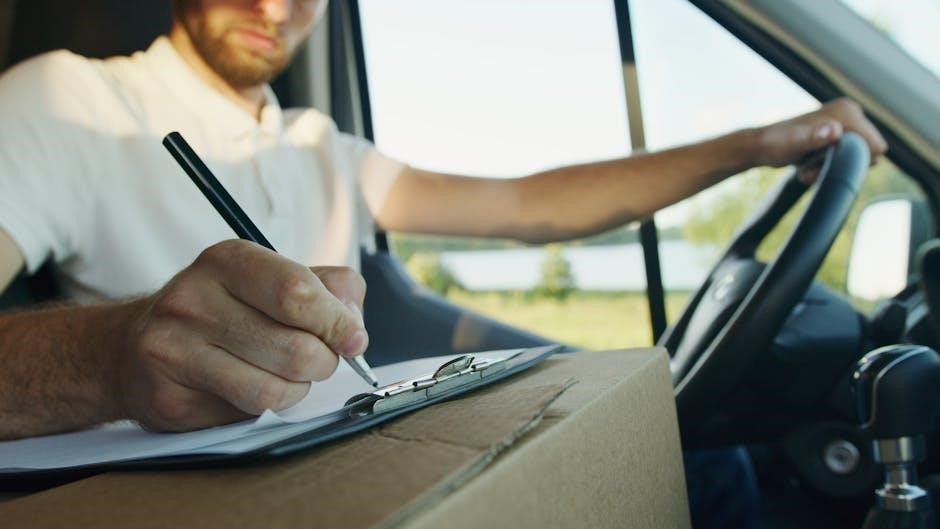DC Driving Manual Overview
The DC Driving Manual provides essential information for obtaining a driver’s license in Washington, D.C. It covers eligibility, knowledge tests, safe driving practices, and traffic laws to ensure residents and new drivers understand the district’s specific traffic environment and regulations.
Welcome to the DC Driving Manual, your guide to safe and lawful driving in Washington, D.C. This manual is designed to help both new and experienced drivers understand the district’s traffic laws, road signs, and driving best practices. It covers essential topics such as eligibility requirements, knowledge test preparation, and safe driving techniques tailored to the unique conditions of the nation’s capital. Whether you’re applying for a driver’s license or seeking to improve your driving skills, this manual provides the information you need to navigate D.C.’s roads confidently and responsibly.
Eligibility Requirements for Obtaining a DC Driver’s License
To obtain a driver’s license in Washington, D.C., applicants must meet specific eligibility requirements. Individuals must be at least 16 years old to apply for a provisional license and 17 years old for a full license. Proof of identity, residency, and Social Security number is mandatory. Applicants must pass a vision test and complete the required application process. Additionally, new residents must surrender their out-of-state license, if applicable. These requirements ensure that all drivers are properly qualified and meet the district’s safety standards before operating a vehicle.
Key Components of the Knowledge Test
The knowledge test for a DC driver’s license evaluates understanding of traffic laws, road signs, and safe driving practices. It covers rules of the road, right-of-way guidelines, and specific regulations in Washington, D.C. The test also includes questions on traffic signals, pedestrian safety, and vehicle safety laws. Applicants must demonstrate knowledge of road signs, including traffic control devices and pavement markings. The test is designed to ensure applicants can operate a vehicle safely and legally within the district. Studying the DC Driving Manual is essential for success, as it contains all necessary information for the exam.
Safe Driving Practices in Washington, D.C.
Safe driving practices in Washington, D.C. emphasize defensive driving, adherence to speed limits, and awareness of the district’s unique traffic conditions. Drivers must yield to pedestrians, follow right-of-way rules, and use seat belts. The manual highlights the importance of maintaining a safe distance from other vehicles and being cautious around large trucks and buses. Night driving requires reduced speeds and increased vigilance. Additionally, drivers are encouraged to avoid distractions, such as using mobile devices, and to be prepared for emergencies. Following these practices helps reduce accidents and ensures a safer driving environment for all road users in the district.

Types of Driver’s Licenses in Washington, D.C.
Washington, D.C. offers Class C, Provisional, and Commercial Driver’s Licenses (CDL), each with specific requirements and privileges, ensuring drivers meet the district’s licensing standards and road safety needs.
Class C Driver’s License
A Class C driver’s license in Washington, D.C. allows operation of non-commercial vehicles, including cars, trucks, and motorcycles under 26,001 pounds. Eligibility requires being at least 17 years old, providing proof of identity, residency, and Social Security, and passing vision, knowledge, and road tests. Applicants under 18 must complete a driver education course. This license is essential for residents needing to drive personal vehicles legally within the district. The DC DMV manual outlines specific requirements and steps to obtain this license, ensuring applicants meet all necessary criteria and understand road safety guidelines.
Provisional Driver’s License

A provisional driver’s license in Washington, D.C. is designed for new drivers, typically those under 18, to gain experience behind the wheel. Eligibility begins at age 16 or 17 with parental consent. Applicants must first hold a learner’s permit for a specific period and complete a driver education course. This license restricts driving without adult supervision, limits the number of passengers, and prohibits driving during late hours. The provisional license phase lasts 12 months before eligibility for a full Class C license, ensuring new drivers develop safe driving habits under controlled conditions.
Commercial Driver’s License (CDL)
A Commercial Driver’s License (CDL) is required for operating vehicles with a gross vehicle weight rating (GVWR) of 26,001 pounds or more, or those designed to transport 16 or more passengers, including the driver. Eligibility begins at age 21, and applicants must pass a physical examination and vision test. A CDL is categorized into Class A, B, and C, with endorsements for specialized vehicles like tankers or school buses. The application process includes a written knowledge test and a skills test, ensuring drivers meet federal safety standards for commercial vehicles. Proper documentation and fees are also required.

Traffic Laws and Regulations
Washington, D.C., enforces strict traffic laws, including speed limits, right-of-way rules, and seat belt requirements. Violations can result in fines or penalties to ensure road safety and order.
Speed Limits in Washington, D.C.
Speed limits in Washington, D.C., are designed to ensure safety on urban and residential roads. The default speed limit is typically 25 mph in residential areas and 30 mph on most urban streets. Near schools and parks, the speed limit may drop to 15 mph during specific hours. On highways and major thoroughfares, limits increase to 50 mph. Drivers must adhere to posted signs, as exceeding these limits can result in fines or penalties. Speed cameras are also used to enforce these regulations, contributing to safer roads for all users.
Right-of-Way Rules
Right-of-way rules in Washington, D.C., are essential for maintaining traffic flow and safety. Drivers must yield to pedestrians in crosswalks and at intersections. At four-way stops, drivers arriving simultaneously give way to those on their right. When approaching unmarked intersections, vehicles on the right have priority. Emergency vehicles, such as ambulances and fire trucks, always have the right of way when their lights and sirens are active. Motorists must also yield to bicyclists and adhere to traffic signals. Understanding and following these rules is crucial to prevent accidents and ensure smooth traffic movement in the district.
Seat Belt and Vehicle Safety Laws
In Washington, D.C., seat belts are mandatory for all drivers and passengers. All vehicles must have a properly functioning seat belt for each occupant, and failure to wear one can result in fines. Child safety laws require children under 8 years old or shorter than 4 feet 9 inches to use a federally approved child safety seat or booster seat. Vehicles must also pass annual safety inspections, which include checks on brakes, tires, and emissions. Drivers are required to ensure all occupants are buckled up, and violations can lead to penalties. These laws aim to enhance road safety and reduce accident-related injuries in the district.

Safe Driving Practices
Safe driving practices in Washington, D.C., emphasize defensive driving techniques, maintaining a safe following distance, adhering to speed limits, and yielding to pedestrians to ensure responsible road behavior.
Defensive Driving Techniques
Defensive driving techniques are crucial for safe navigation in Washington, D.C. These include staying alert, maintaining a safe distance, and anticipating other drivers’ actions. Drivers should always be prepared to react to unexpected situations, such as sudden stops or pedestrians stepping into the road. Avoid distractions like using a phone while driving and keep eyes on the road. Additionally, understanding traffic signals and right-of-way rules helps in making informed decisions. By practicing these techniques, drivers can reduce the risk of accidents and ensure a safer environment for everyone on the road.
Sharing the Road with Pedestrians and Cyclists
Sharing the road with pedestrians and cyclists is essential for maintaining safety in Washington, D.C. Drivers must always yield to pedestrians at crosswalks and be vigilant in areas with high foot traffic. When approaching cyclists, drivers should maintain a safe distance and use caution when passing. DC law requires drivers to give cyclists at least 3 feet of space when overtaking. Additionally, drivers should avoid blocking bike lanes or pedestrian paths. By respecting the rights of all road users, drivers can help create a safer and more harmonious traffic environment for everyone.
Emergency Procedures and Accident Response
In the event of an accident or emergency, drivers in Washington, D.C. must follow specific procedures to ensure safety and compliance with the law. Move your vehicle to a safe location, if possible, and turn on hazard lights to alert other drivers. Contact the Metropolitan Police Department to report the incident, especially if there are injuries or significant damage. Exchange information with all parties involved, including names, contact details, and insurance information. Provide assistance to anyone injured and document the scene with photos or notes. Failure to report an accident or provide aid when required can result in legal consequences. Always stay calm and follow DC’s accident response guidelines to minimize risks and ensure proper handling of the situation.

CDL Manual Specifics
The CDL manual outlines requirements and guidelines for commercial drivers in Washington, D.C., including vehicle operation standards, safety protocols, and pre-trip inspection procedures to ensure road safety and compliance with federal and local regulations. Drivers must adhere to specific rules regarding hours of service, cargo securement, and liability insurance to maintain their commercial license and operate heavy vehicles legally within the district.
Eligibility Criteria for a Commercial Driver’s License
To qualify for a Commercial Driver’s License (CDL) in Washington, D.C., applicants must meet specific criteria. They must be at least 21 years old, provide proof of residency, and pass a medical examination to ensure physical fitness for operating heavy vehicles. A valid Social Security number and proper identification are required. Applicants must also pass a vision test and undergo a background check. Additionally, they must not have any disqualifying offenses on their driving record. The DC DMV requires completion of a CDL application and payment of the applicable fees. Certain endorsements, such as hazardous materials or passenger transport, may require additional testing and clearance. Drivers with suspended or revoked licenses are ineligible until their driving privileges are reinstated. A valid medical certificate is mandatory for maintaining CDL eligibility, and applicants must demonstrate proficiency in operating commercial vehicles through a skills test. Vision standards are strictly enforced, with corrective lenses permitted if necessary. Failure to meet any of these criteria will result in denial of the CDL application. The DC DMV adheres to federal regulations to ensure public safety on the roads.
Required Knowledge and Skills for CDL Holders
CDL holders in Washington, D.C. must possess comprehensive knowledge of traffic laws, safe driving practices, and specific skills for operating commercial vehicles. They must understand how to handle large vehicles, including braking techniques and weight distribution. Proficiency in pre-trip inspections, air brake systems, and cargo securement is essential. Knowledge of hazardous materials handling, if applicable, is also required. CDL holders must demonstrate the ability to navigate challenging road conditions and adhere to federal and local regulations. They must also be skilled in emergency procedures, such as handling skids or breakdowns, and ensure passenger and cargo safety at all times. Continuous adherence to these standards is critical for maintaining public safety on the roads.
CDL Testing and Certification Process
Obtaining a CDL in Washington, D.C. involves a rigorous testing and certification process. Applicants must first pass a written knowledge test covering traffic laws, safe driving practices, and specific endorsements such as Hazmat or Passenger. A skills test follows, assessing pre-trip inspection, basic vehicle control, and on-road driving abilities. Certification requires submitting a valid medical examiner’s certificate and completing a background check for certain endorsements. Upon passing all requirements, applicants receive their CDL, enabling them to operate commercial vehicles legally in the district. Regular renewals and adherence to federal regulations are also mandated to maintain certification.

Vehicle Registration and Insurance
Vehicle registration in DC requires annual fees, insurance proof, and passing inspections. Drivers must maintain minimum liability coverage to legally operate vehicles in Washington, D.C.
Vehicle Registration Requirements in DC
Registering a vehicle in Washington, D.C., requires proof of residency, a valid title, and insurance. Owners must pay annual fees and pass emissions and safety inspections. DC DMV mandates that all vehicles be registered within 30 days of establishing residency. Additional documentation, such as a smog certification, may be needed for older vehicles. Failure to register on time may result in penalties. Residents can renew registrations online or in person, ensuring compliance with district regulations to maintain legal driving privileges.
Insurance Requirements for Drivers in Washington, D.C.
In Washington, D.C., drivers must carry minimum liability insurance coverage of $25,000 for bodily injury per person, $50,000 per accident, and $10,000 for property damage. Proof of insurance must be provided when registering a vehicle or during a traffic stop. Drivers may also opt for additional coverage, such as collision or comprehensive insurance. Failure to maintain valid insurance can result in fines, license suspension, or vehicle impoundment. The DC DMV requires insurance providers to be licensed in the District. Drivers must carry an insurance identification card as proof of coverage while operating a vehicle.

